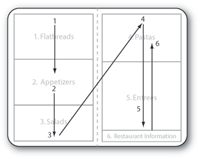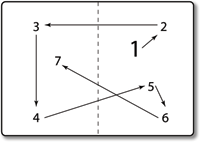 The accepted wisdom among restaurant menu designers has long been that there’s a proverbial “sweet spot” that lies just above the midline on the right hand side of the page. That’s where operators should list high-margin items, preferably highlighting them with graphic treatments to further attract the customer’s eye. Now one researcher is suggesting that sweet spot doesn’t really exist.
The accepted wisdom among restaurant menu designers has long been that there’s a proverbial “sweet spot” that lies just above the midline on the right hand side of the page. That’s where operators should list high-margin items, preferably highlighting them with graphic treatments to further attract the customer’s eye. Now one researcher is suggesting that sweet spot doesn’t really exist.
When San Francisco State professor and restaurant revenue generation whiz Dr. Sybil Yang began to explore the sweet spot theory of menu design, she found little data to support it. “The restaurant industry has been piggybacking off past research,” she says. “It’s like a bad rumor that just kept perpetuating.”
Yang’s idea was to come up with new data about how customers read menus. She designed an experiment in which test subjects wore an infrared retinal eye scanner while reading through mock menus. Those subjects would then order their meal. Yang then analyzed the resulting video to trace the subjects’ eye movements—known as scanpaths—as they made their way through the menu.
The results: people read menus much the same as they read books—sequentially, moving their eyes from left to right down the pages of a two-page menu. And they read slowly, which Yang says means they are reading for information, not just scanning or jumping from item to item. “In a restaurant, you have an audience with the motivation to read the entire thing,” she says.
But was there a sweet spot? Yang says her research didn’t find one, although she did find what she dubbed a “sour spot”: those sections of the menu that contain general information about a restaurant and its salad list. Customers don’t spend much time there.
Is any of this information applicable to you?
“The good news for restaurants is that people are reading the menus carefully, and that they seem to be choosing an entrée and then building a meal around it,” Yang says. She adds that when she shows her data to real-world restaurant operators, they say “that this makes absolute sense and that they’re glad to have the empirical data.”
Yang’s no slouch as a menu researcher, or at applying that research to practical restaurant situations. Some of her previous work looked at menu price formatting (numerals with a dollar sign, numerals without a dollar sign, or prices written out with no numbers or dollar signs) and how it relates to subsequent sales.
She has also taught financial management to bachelor program students and menu development in the associates degree program at the Culinary Institute of America. Her consulting work has been done for hospitality businesses ranging from Scala’s Bistro in San Francisco to Gaylord Opryland in Nashville. Plus she’s actually worked in real restaurants. One of Yang’s other research projects involves what she dubs “decoy” items. “These are items that are never meant to be chosen, but are placed there to affect your other choices,” Yang says. Sounds like a fruitful line of inquiry to us.
One of Yang’s other research projects involves what she dubs “decoy” items. “These are items that are never meant to be chosen, but are placed there to affect your other choices,” Yang says. Sounds like a fruitful line of inquiry to us.
In the meantime, Yang’s study, “Eye Movements on Restaurant Menus: A Revisitation on Gaze Motion and Consumer Scanpaths,” appears in the current issue of the International Journal of Hospitality Management.
Traditional menu engineering techniques have proven their worth over several decades. But keep an eye on Yang’s approach. Her work on how contemporary restaurant customers interact with menus may help you squeeze another percent or two of profit out of your operation.
Menu Engineering Gets A Makeover
0 comments
Hide comments




